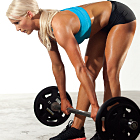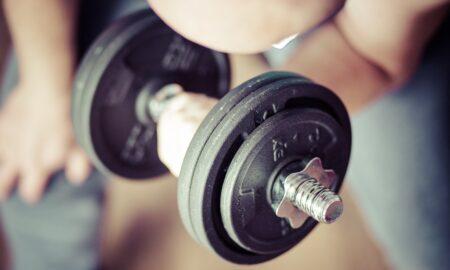 In the last installment, I discussed the different set-and-rep formulas I like for high-skill moves like the Olympic lifts as well as front squats, high pulls and jerks from the rack—three reps per set. I also touched on almost-straight-legged deadlifts.
In the last installment, I discussed the different set-and-rep formulas I like for high-skill moves like the Olympic lifts as well as front squats, high pulls and jerks from the rack—three reps per set. I also touched on almost-straight-legged deadlifts.
For those I like eights and 10s. I use higher reps here for the same reason I use them on good mornings for almost all of my athletes—it’s easier to maintain perfect form. With fives the weights get really, really heavy, and the almost-straight-legged deadlifts turns into regular deadlifts.
Once athletes have had time to establish a solid strength base and learn how to perform every exercise in their program correctly, if not perfectly, I start changing the set-and-rep formula on many of the primary exercises on a weekly basis. Change is always stimulating to some degree, and it also works the target muscles and corresponding attachments in a slightly different manner. Both of those things result in more progress on an exercise.
That idea works particularly well on back and shoulder girdle exercises. For the legs I pretty much stick with threes and fives across the board—as I do for front and back squats. For pulling movements and flat-bench, incline and overhead presses, I call for five sets of five one week, then two sets of five the next week, followed by three to four sets of three the next. Then it’s back to fives, with the following week consisting of doubles or singles. For trainees who are at least intermediates, I have them do a back-off set of eight or 10 after the lower reps.
All of these fit together nicely. The fives, threes, doubles and singles hit the attachments, while the higher reps add to the total volume for that -bodypart that day. Even the slight changes with good mornings and almost-straight-legged deadlifts make a difference.
Here’s a formula I’ve found most productive for deadlifts and weighted dips: week 1, 4 x 8; week 2, 5 x 5; week 3, 2 x 5, 3-4 x 3; week 4, 2 x 5, 2-4 x 1.
Keep in mind that no one set-and-rep formula fits everyone. What works well for your training partner, even if he is the same age and size as you, may not work for you. That’s the reason you always need to make some adjustments in programs that are presented in books and magazines—so they are compatible with your individual needs. That’s true of every aspect of strength training. You must take the data presented and modify it for you.
I had a lacrosse player, Scott Mollica of Massapequa Park, New York, who always did his inclines for seven reps. He said that was his lucky number. He made steady progress and was the strongest incliner on the team, so I didn’t bother trying to persuade him to change.
One final note on the topic of sets and reps. The guidelines I’ve presented are for younger athletes who are striving to gain size and strength. They do not apply to older athletes, whose needs and bodies are quite different and require an entirely different approach to staying physically fit. Primarily, older athletes do not want to involve their attachments nearly as much as their stronger counterparts do, which means much higher reps are the order of the day. I’ll present a discussion just for them in a future installment.
Editor’s note: Bill Starr was a strength and conditioning coach at Johns Hopkins University from 1989 to 2000. He’s the author of The Strongest Shall Survive—Strength Training for Football, which is available for $20 plus shipping from Home Gym Warehouse. Call (800) 447-0008, or visit www.Home-Gym.com.




















You must be logged in to post a comment Login